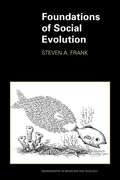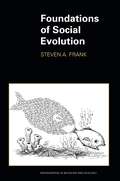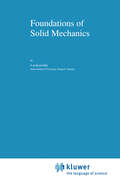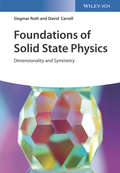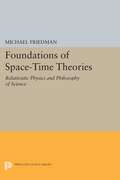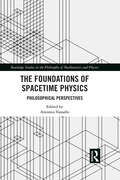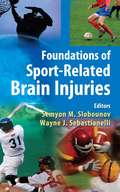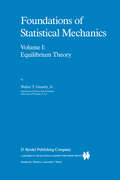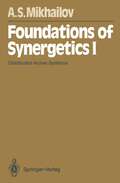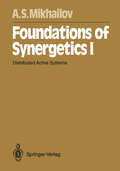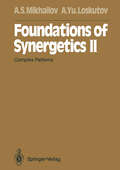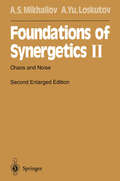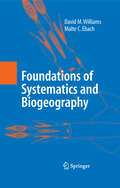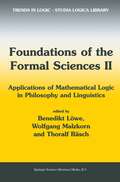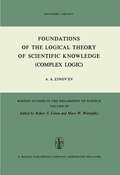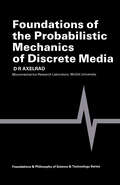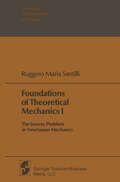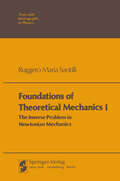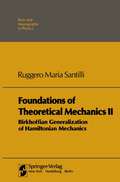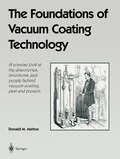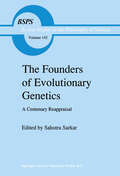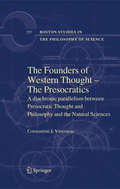- Table View
- List View
Foundations of Social Evolution
by Steven A. FrankThis is a masterly theoretical treatment of one of the central problems in evolutionary biology, the evolution of social cooperation and conflict. Steven Frank tackles the problem with a highly original combination of approaches: game theory, classical models of natural selection, quantitative genetics, and kin selection. He unites these with the best of economic thought: a clear theory of model formation and comparative statics, the development of simple methods for analyzing complex problems, and notions of information and rationality. Using this unique, multidisciplinary approach, Frank makes major advances in understanding the foundations of social evolution. Frank begins by developing the three measures of value used in biology--marginal value, reproductive value, and kin selection. He then combines these measures into a coherent framework, providing the first unified analysis of social evolution in its full ecological and demographic context. Frank also extends the theory of kin selection by showing that relatedness has two distinct meanings. The first is a measure of information about social partners, with close affinity to theories of correlated equilibrium and Bayesian rationality in economic game theory. The second is a measure of the fidelity by which characters are transmitted to future generations--an extended notion of heritability. Throughout, Frank illustrates his methods with many examples, including a complete reformulation of the theory of sex allocation. The book also provides a unique "how-to" guide for constructing models of social behavior. It is essential reading for evolutionary biologists and for economists, mathematicians, and others interested in natural selection.
Foundations of Social Evolution (Monographs in Behavior and Ecology #2)
by Steven A. FrankThis is a masterly theoretical treatment of one of the central problems in evolutionary biology, the evolution of social cooperation and conflict. Steven Frank tackles the problem with a highly original combination of approaches: game theory, classical models of natural selection, quantitative genetics, and kin selection. He unites these with the best of economic thought: a clear theory of model formation and comparative statics, the development of simple methods for analyzing complex problems, and notions of information and rationality. Using this unique, multidisciplinary approach, Frank makes major advances in understanding the foundations of social evolution. Frank begins by developing the three measures of value used in biology--marginal value, reproductive value, and kin selection. He then combines these measures into a coherent framework, providing the first unified analysis of social evolution in its full ecological and demographic context. Frank also extends the theory of kin selection by showing that relatedness has two distinct meanings. The first is a measure of information about social partners, with close affinity to theories of correlated equilibrium and Bayesian rationality in economic game theory. The second is a measure of the fidelity by which characters are transmitted to future generations--an extended notion of heritability. Throughout, Frank illustrates his methods with many examples, including a complete reformulation of the theory of sex allocation. The book also provides a unique "how-to" guide for constructing models of social behavior. It is essential reading for evolutionary biologists and for economists, mathematicians, and others interested in natural selection.
Foundations of Solid Mechanics (Solid Mechanics and Its Applications #3)
by P. KarasudhiThis book has been written with two purposes, as a textbook for engineering courses and as a reference book for engineers and scientists. The book is an outcome of several lecture courses. These include lectures given to graduate students at the Asian Institute of Technology for several years, a course on elasticity for University of Tokyo graduate students in the spring of 1979, and courses on elasticity, viscoelasticity and ftnite deformation at the National University of Singapore from May to November 1985. In preparing this book, I kept three objectives in mind: ftrst, to provide sound fundamental knowledge of solid mechanics in the simplest language possible; second, to introduce effective analytical and numerical solution methods; and third, to impress on readers that the subject is beautiful, and is accessible to those with only a standard mathematical background. In order to meet those objectives, the ftrst chapter of the book is a review of mathematical foundations intended for anyone whose background is an elementary knowledge of differential calculus, scalars and vectors, and Newton's laws of motion. Cartesian tensors are introduced carefully. From then on, only Cartesian tensors in the indicial notation, with subscript as indices, are used to derive and represent all theories.
Foundations of Solid State Physics: Dimensionality and Symmetry
by Siegmar Roth David CarrollAn essential guide to solid state physics through the lens of dimensionality and symmetry Foundations of Solid State Physics introduces the essential topics of solid state physics as taught globally with a focus on understanding the properties of solids from the viewpoint of dimensionality and symmetry. Written in a conversational manner and designed to be accessible, the book contains a minimal amount of mathematics. The authors?noted experts on the topic?offer an insightful review of the basic topics, such as the static and dynamic lattice in real space, the reciprocal lattice, electrons in solids, and transport in materials and devices. The book also includes more advanced topics: the quasi-particle concept (phonons, solitons, polarons, excitons), strong electron-electron correlation, light-matter interactions, and spin systems. The authors' approach makes it possible to gain a clear understanding of conducting polymers, carbon nanotubes, nanowires, two-dimensional chalcogenides, perovskites and organic crystals in terms of their expressed dimension, topological connectedness, and quantum confinement. This important guide: -Offers an understanding of a variety of technology-relevant solid-state materials in terms of their dimension, topology and quantum confinement -Contains end-of-chapter problems with different degrees of difficulty to enhance understanding -Treats all classical topics of solid state physics courses - plus the physics of low-dimensional systems Written for students in physics, material sciences, and chemistry, lecturers, and other academics, Foundations of Solid State Physics explores the basic and advanced topics of solid state physics with a unique focus on dimensionality and symmetry.
Foundations of Solid State Physics: Dimensionality and Symmetry
by Siegmar Roth David CarrollAn essential guide to solid state physics through the lens of dimensionality and symmetry Foundations of Solid State Physics introduces the essential topics of solid state physics as taught globally with a focus on understanding the properties of solids from the viewpoint of dimensionality and symmetry. Written in a conversational manner and designed to be accessible, the book contains a minimal amount of mathematics. The authors?noted experts on the topic?offer an insightful review of the basic topics, such as the static and dynamic lattice in real space, the reciprocal lattice, electrons in solids, and transport in materials and devices. The book also includes more advanced topics: the quasi-particle concept (phonons, solitons, polarons, excitons), strong electron-electron correlation, light-matter interactions, and spin systems. The authors' approach makes it possible to gain a clear understanding of conducting polymers, carbon nanotubes, nanowires, two-dimensional chalcogenides, perovskites and organic crystals in terms of their expressed dimension, topological connectedness, and quantum confinement. This important guide: -Offers an understanding of a variety of technology-relevant solid-state materials in terms of their dimension, topology and quantum confinement -Contains end-of-chapter problems with different degrees of difficulty to enhance understanding -Treats all classical topics of solid state physics courses - plus the physics of low-dimensional systems Written for students in physics, material sciences, and chemistry, lecturers, and other academics, Foundations of Solid State Physics explores the basic and advanced topics of solid state physics with a unique focus on dimensionality and symmetry.
Foundations of Space-Time Theories: Relativistic Physics and Philosophy of Science
by Michael FriedmanThis book, explores the conceptual foundations of Einstein's theory of relativity: the fascinating, yet tangled, web of philosophical, mathematical, and physical ideas that is the source of the theory's enduring philosophical interest.Originally published in 1983.The Princeton Legacy Library uses the latest print-on-demand technology to again make available previously out-of-print books from the distinguished backlist of Princeton University Press. These editions preserve the original texts of these important books while presenting them in durable paperback and hardcover editions. The goal of the Princeton Legacy Library is to vastly increase access to the rich scholarly heritage found in the thousands of books published by Princeton University Press since its founding in 1905.
The Foundations of Spacetime Physics: Philosophical Perspectives (Routledge Studies in the Philosophy of Mathematics and Physics)
by Antonio VassalloThis book provides an up-to-date overview of the foundations of spacetime physics. It features original essays written by world-class experts in the physics and philosophy of spacetime. The foundational questions regarding the origin and nature of spacetime are branching into new and exciting directions. These questions are not restricted to the quantum gravity program but also arise in the context of a well-established theory like general relativity. Against the background of these quick and diverse developments, this volume features a broad range of perspectives on spacetime. Part I focuses on the nature of spacetime in non-quantum theories, such as Newtonian mechanics and relativity. Part II explores some intriguing conceptual implications of developing a quantum theory of spacetime. The Foundations of Spacetime Physics is an essential resource for scholars and advanced students working in philosophy of physics, philosophy of science, and scientific metaphysics.
The Foundations of Spacetime Physics: Philosophical Perspectives (Routledge Studies in the Philosophy of Mathematics and Physics)
by Antonio VassalloThis book provides an up-to-date overview of the foundations of spacetime physics. It features original essays written by world-class experts in the physics and philosophy of spacetime. The foundational questions regarding the origin and nature of spacetime are branching into new and exciting directions. These questions are not restricted to the quantum gravity program but also arise in the context of a well-established theory like general relativity. Against the background of these quick and diverse developments, this volume features a broad range of perspectives on spacetime. Part I focuses on the nature of spacetime in non-quantum theories, such as Newtonian mechanics and relativity. Part II explores some intriguing conceptual implications of developing a quantum theory of spacetime. The Foundations of Spacetime Physics is an essential resource for scholars and advanced students working in philosophy of physics, philosophy of science, and scientific metaphysics.
Foundations of Sport-Related Brain Injuries
by Semyon M. Slobounov Wayne J. SebastianelliIn summarizing current insights and controversies over concussions in athletics, this book makes the vital point that symptom resolution does not necessarily mean injury resolution. Research shows that dysfunctional pathways continue for extended periods even after a minor concussion. Until the consequences of short-term perturbations and long-term residual brain dysfunctions are better understood, concussions must be treated with respect and given a higher priority for continued research activity.
Foundations of Statistical Mechanics: Equilibrium Theory (Fundamental Theories of Physics #19)
by W.T. Grandy Jr.In a certain sense this book has been twenty-five years in the writing, since I first struggled with the foundations of the subject as a graduate student. It has taken that long to develop a deep appreciation of what Gibbs was attempting to convey to us near the end of his life and to understand fully the same ideas as resurrected by E.T. Jaynes much later. Many classes of students were destined to help me sharpen these thoughts before I finally felt confident that, for me at least, the foundations of the subject had been clarified sufficiently. More than anything, this work strives to address the following questions: What is statistical mechanics? Why is this approach so extraordinarily effective in describing bulk matter in terms of its constituents? The response given here is in the form of a very definite point of view-the principle of maximum entropy (PME). There have been earlier attempts to approach the subject in this way, to be sure, reflected in the books by Tribus [Thermostat ics and Thermodynamics, Van Nostrand, 1961], Baierlein [Atoms and Information Theory, Freeman, 1971], and Hobson [Concepts in Statistical Mechanics, Gordon and Breach, 1971].
Foundations of Synergetics I: Distributed Active Systems (Springer Series in Synergetics #51)
by Alexander S. MikhailovThis book gives an introduction to the mathematical theory of cooperative behavior in active systems of various origins, both natural and artificial. It is based on a lecture course in synergetics which I held for almost ten years at the University of Moscow. The first volume deals mainly with the problems of pattern fonnation and the properties of self-organized regular patterns in distributed active systems. It also contains a discussion of distributed analog information processing which is based on the cooperative dynamics of active systems. The second volume is devoted to the stochastic aspects of self-organization and the properties of self-established chaos. I have tried to avoid delving into particular applications. The primary intention is to present general mathematical models that describe the principal kinds of coopera tive behavior in distributed active systems. Simple examples, ranging from chemical physics to economics, serve only as illustrations of the typical context in which a particular model can apply. The manner of exposition is more in the tradition of theoretical physics than of in mathematics: Elaborate fonnal proofs and rigorous estimates are often replaced the text by arguments based on an intuitive understanding of the relevant models. Because of the interdisciplinary nature of this book, its readers might well come from very diverse fields of endeavor. It was therefore desirable to minimize the re quired preliminary knowledge. Generally, a standard university course in differential calculus and linear algebra is sufficient.
Foundations of Synergetics I: Distributed Active Systems (Springer Series in Synergetics #51)
by Alexander S. MikhailovThis book gives an introduction to the mathematical theory of cooperative behavior in active systems of various origins, both natural and artificial. It is based on a lecture course in synergetics which I held for almost ten years at the University of Moscow. The first volume deals mainly with the problems of pattern formation and the properties of self-organized regular patterns in distributed active systems. It also contains a discussion of distributed analog information processing which is based on the cooperative dynamics of active systems. The second volume is devoted to the stochastic aspects of self-organization and the properties of self-established chaos. I have tried to avoid delving into particular applications. The primary intention is to present general mathematical models that describe the principal kinds of coopera tive behavior in distributed active systems. Simple examples, ranging from chemical physics to economics, serve only as illustrations of the typical context in which a particular model can apply. The manner of exposition is more in the tradition of theoretical physics than of mathematics: Elaborate formal proofs and rigorous estimates are often replaced in the text by arguments based on an intuitive understanding of the relevant models. Because of the interdisciplinary nature of this book, its readers might well come from very diverse fields of endeavor. It was therefore desirable to minimize the re quired preliminary knowledge. Generally, a standard university course in differential calculus and linear algebra is sufficient.
Foundations of Synergetics II: Complex Patterns (Springer Series in Synergetics #52)
by Alexander S. Mikhailov Alexander Yu. LoskutovThis textbook is based on a lecture course in synergetics given at the University of Moscow. In this second of two volumes, we discuss the emergence and properties of complex chaotic patterns in distributed active systems. Such patterns can be produced autonomously by a system, or can result from selective amplification of fluctuations caused by external weak noise. Although the material in this book is often described by refined mathematical theories, we have tried to avoid a formal mathematical style. Instead of rigorous proofs, the reader will usually be offered only "demonstrations" (the term used by Prof. V. I. Arnold) to encourage intuitive understanding of a problem and to explain why a particular statement seems plausible. We also refrained from detailing concrete applications in physics or in other scientific fields, so that the book can be used by students of different disciplines. While preparing the lecture course and producing this book, we had intensive discussions with and asked the advice of Prof. V. I. Arnold, Prof. S. Grossmann, Prof. H. Haken, Prof. Yu. L. Klimontovich, Prof. R. L. Stratonovich and Prof. Ya.
Foundations of Synergetics II: Chaos and Noise (Springer Series in Synergetics #52)
by Alexander S. Mikhailov Alexander Yu. LoskutovThe second edition of this volume has been extensively revised. A different version of Chap. 7, reflecting recent significant progress in understanding of spatiotempo ral chaos, is now provided. Much new material has been included in the sections dealing with intermittency in birth-death models and noise-induced phase transi tions. A new section on control of chaotic behavior has been added to Chap. 6. The subtitle of the volume has been changed to better reflect its contents. We acknowledge stimulating discussions with H. Haken and E. Scholl and are grateful to our colleagues M. Bar, D. Battogtokh, M. Eiswirth, M. Hildebrand, K. Krischer, and V. Tereshko for their comments and assistance. We thank M. Lubke for her help in producing new figures for this volume. Berlin and Moscow A. s. Mikhailov April 1996 A. Yu. Loskutov Preface to the First Edition This textbook is based on a lecture course in synergetics given at the University of Moscow. In this second of two volumes, we discuss the emergence and properties of complex chaotic patterns in distributed active systems. Such patterns can be produced autonomously by a system, or can result from selective amplification of fluctuations caused by external weak noise.
Foundations of Systematics and Biogeography
by David M. Williams Malte C. EbachAnyone interested in comparative biology or the history of science will find this myth-busting work genuinely fascinating. It draws attention to the seminal studies and important advances that have shaped systematic and biogeographic thinking. It traces concepts in homology and classification from the 19th century to the present through the provision of a unique anthology of scientific writings from Goethe, Agassiz, Owen, Naef, Zangerl and Nelson, among others.
Foundations of Systems Biology: Using Cell Illustrator and Pathway Databases (Computational Biology #13)
by Masao Nagasaki Ayumu Saito Atsushi Doi Hiroshi Matsuno Satoru MiyanoToday, as hundreds of genomes have been sequenced and thousands of proteins and more than ten thousand metabolites have been identi?ed, navigating safely through this wealth of information without getting completely lost has become crucial for research in, and teaching of, molecular biology. Consequently, a considerable number of tools have been developed and put on the market in the last two decades that describe the multitude of potential/putative interactions between genes, proteins, metabolites, and other biologically relevant compounds in terms of metabolic, genetic, signaling, and other networks, their aim being to support all sorts of explorations through bio-data bases currently called Systems Biology. As a result, navigating safely through this wealth of information-processing tools has become equally crucial for successful work in molecular biology. To help perform such navigation tasks successfully, this book starts by providing an extremely useful overview of existing tools for ?nding (or designing) and inv- tigating metabolic, genetic, signaling, and other network databases, addressing also user-relevant practical questions like • Is the database viewable through a web browser? • Is there a licensing fee? • What is the data type (metabolic, gene regulatory, signaling, etc. )? • Is the database developed/maintained by a curator or a computer? • Is there any software for editing pathways? • Is it possible to simulate the pathway? It then goes on to introduce a speci?c such tool, that is, the fabulous “Cell - lustrator 3. 0” tool developed by the authors.
Foundations of the Formal Sciences II: Applications of Mathematical Logic in Philosophy and Linguistics (Trends in Logic #17)
by Benedikt Löwe Wolfgang Malzkorn Thoralf Räsch"Foundations of the Formal Sciences" (FotFS) is a series of interdisciplinary conferences in mathematics, philosophy, computer science and linguistics. The main goal is to reestablish the traditionally strong links between these areas of research that have been lost in the past decades. The second conference in the series had the subtitle "Applications of Mathematical Logic in Philosophy and Linguistics" and brought speakers from all parts of the Formal Sciences together to give a holistic view of how mathematical methods can improve our philosophical and technical understanding of language and scientific discourse, ranging from the theoretical level up to applications in language recognition software. Audience: This volume is of interest to all formal philosophers and theoretical linguists. In addition to that, logicians interested in the applications of their field and logic students in mathematics, computer science, philosophy and linguistics can use the volume to broaden their knowledge of applications of logic.
Foundations of the Logical Theory of Scientific Knowledge (Boston Studies in the Philosophy and History of Science #9)
by A.A. Zinov'evBoston Studies in the Philosophy of Science are devoted to symposia, con gresses, colloquia, monographs and collected papers on the philosophical foundations of the sciences. It is now our pleasure to include A. A. Zi nov'ev's treatise on complex logic among these volumes. Zinov'ev is one of the most creative of modern Soviet logicians, and at the same time an innovative worker on the methodological foundations of science. More over, Zinov'ev, although still a developing scholar, has exerted a sub stantial and stimulating influence upon his colleagues and students in Moscow and within other philosophical and logical circles of the Soviet Union. Hence it may be helpful, in bringing this present work to an English-reading audience, to review briefly some contemporary Soviet investigations into scientific methodology. During the 1950's, a vigorous new research program in logic was under taken, and the initial published work -characteristic of most Soviet pub lications in the logic and methodology of the sciences - was a collection of essays, Logical Investigations (Moscow, 1959). Among the authors, in addition to Zinov'ev himself, were the philosophers A. Kol'man and P. V. Tavanec, and the mathematicians and linguists, S. A. Janovskaja, A. S. Esenin-Vol'pin, S. K. Saumjan, G. N. Povarov.
Foundations of the Probabilistic Mechanics of Discrete Media (Foundations and Philosophy of Science and Technology)
by D. R. AxelradThis latest volume in the Foundations & Philosophy of Science & Technology series provides an account of probabilistic functional analysis and shows its applicability in the formulation of the behaviour of discrete media with the inclusion of microstructural effects. Although quantum mechanics have long been recognized as a stochastic theory, the introduction of probabilistic concepts and principles to classical mechanics has in general not been attempted. In this study the author takes the view that the significant field quantities of a discrete medium are random variables or functions of such variables. Hence the probabilistic mechanics of discrete media are based on the mathematical theory of probability and the axiomatics of measure theory.
Foundations of Theoretical Mechanics I: The Inverse Problem in Newtonian Mechanics (Texts and Monographs in Physics)
by Ruggero Maria SantilliThe objective of this monograph is to present some methodological foundations of theoretical mechanics that are recommendable to graduate students prior to, or jointly with, the study of more advanced topics such as statistical mechanics, thermodynamics, and elementary particle physics. A program of this nature is inevitably centered on the methodological foundations for Newtonian systems, with particular reference to the central equations of our theories, that is, Lagrange's and Hamilton's equations. This program, realized through a study of the analytic representations in terms of Lagrange's and Hamilton's equations of generally nonconservative Newtonian systems (namely, systems with Newtonian forces not necessarily derivable from a potential function), falls within the context of the so-called Inverse Problem, and consists of three major aspects: l. The study of the necessary and sufficient conditions for the existence of a Lagrangian or Hamiltonian representation of given equations of motion with arbitrary forces; 2. The identification of the methods for the construction of a Lagrangian or Hamiltonian from given equations of motion verifying conditions 1; and 3 The analysis of the significance of the underlying methodology for other aspects of Newtonian Mechanics, e. g. , transformation theory, symmetries, and first integrals for nonconservative Newtonian systems. This first volume is devoted to the foundations of the Inverse Problem, with particular reference to aspects I and 2.
Foundations of Theoretical Mechanics I: The Inverse Problem in Newtonian Mechanics (Theoretical and Mathematical Physics)
by Ruggero Maria SantilliThe objective of this monograph is to present some methodological foundations of theoretical mechanics that are recommendable to graduate students prior to, or jointly with, the study of more advanced topics such as statistical mechanics, thermodynamics, and elementary particle physics. A program of this nature is inevitably centered on the methodological foundations for Newtonian systems, with particular reference to the central equations of our theories, that is, Lagrange's and Hamilton's equations. This program, realized through a study of the analytic representations in terms of Lagrange's and Hamilton's equations of generally nonconservative Newtonian systems (namely, systems with Newtonian forces not necessarily derivable from a potential function), falls within the context of the so-called Inverse Problem, and consists of three major aspects: I. The study of the necessary and sufficient conditions for the existence of a Lagrangian or Hamiltonian representation of given equations of motion with arbitrary forces; 1. The identification of the methods for the construction of a Lagrangian or Hamiltonian from the given equations of motion; and 3. The analysis of the significance of the underlying methodology for other aspects of Newtonian Mechanics, e. g. , transformation theory, symmetries, and first integrals for nonconservative Newtonian systems. This first volume is devoted to the foundations of the Inverse Problem, with particular reference to aspects I and 2.
Foundations of Theoretical Mechanics II: Birkhoffian Generalizations of Hamiltonian Mechanics (Theoretical and Mathematical Physics)
by Ruggero Maria SantilliIn the preceding volume,l I identified necessary and sufficient conditions for the existence of a representation of given Newtonian systems via a variational principle, the so-called conditions of variational self-adjointness. A primary objective of this volume is to establish that all Newtonian systems satisfying certain locality, regularity, and smoothness conditions, whether conservative or nonconservative, can be treated via conventional variational principles, Lie algebra techniques, and symplectic geometrical formulations. This volume therefore resolves a controversy on the repre sentational capabilities of conventional variational principles that has been 2 lingering in the literature for over a century, as reported in Chart 1. 3. 1. The primary results of this volume are the following. In Chapter 4,3 I prove a Theorem of Direct Universality of the Inverse Problem. It establishes the existence, via a variational principle, of a representation for all Newtonian systems of the class admitted (universality) in the coordinates and time variables of the experimenter (direct universality). The underlying analytic equations turn out to be a generalization of conventional Hamilton equations (those without external terms) which: (a) admit the most general possible action functional for first-order systems; (b) possess a Lie algebra structure in the most general possible, regular realization of the product; and (c) 1 Santilli (1978a). As was the case for Volume I, the references are listed at the end of this volume, first in chronological order and then in alphabetic order.
The Foundations of Vacuum Coating Technology
by Donald M. MattoxIntroduction . . . . . . . . . . . . . . . . . . . . . . . . . . . . . . . . . . . . . . . . . . . . . . . . . . . . . . . . . . . . . . . . . . . . . . . . . . . . . . . . . . . . . . . . . . . . . . . . . . . . . . . . . . . . . . . . . . . . . . . . . . . . . . . . . . . . . . . . . . . . . . . . . . . . . . . . . . . . 1 Early Vacuum Science and Technology . . . . . . . . . . . . . . . . . . . . . . . . . . . . . . . . . . . . . . . . . . . . . . . . . . . . . . . . . . . . . . . . . . . . . . . . . . . . . . . . . . . . . . . . . . . . . . . . . . . . . . . . . . . . . . . . . 2 Early Electricity and Magnetism . . . . . . . . . . . . . . . . . . . . . . . . . . . . . . . . . . . . . . . . . . . . . . . . . . . . . . . . . . . . . . . . . . . . . . . . . . . . . . . . . . . . . . . . . . . . . . . . . . . . . . . . . . . . . . . . . . . . . . . . . . . . 5 Early Plasma Physics and Chemistry . . . . . . . . . . . . . . . . . . . . . . . . . . . . . . . . . . . . . . . . . . . . . . . . . . . . . . . . . . . . . . . . . . . . . . . . . . . . . . . . . . . . . . . . . . . . . . . . . . . . . . . . . . . . . . . . . . . . . 7 Some Scientific and Engineering Societies and Publications . . . . . . . . . . . . . . . . . . . . . . . . . . . . . . . . . . . . . . . . . . . . . . . . . . . . . . . . . . . . . . . . . . . . . . . . . . . . . . . . 9 Patents and the U. S. Patent Office . . . . . . . . . . . . . . . . . . . . . . . . . . . . . . . . . . . . . . . . . . . . . . . . . . . . . . . . . . . . . . . . . . . . . . . . . . . . . . . . . . . . . . . . . . . . . . . . . . . . . . . . . . . . . . . . . . . . . . . 10 Deposition Processes . . . . . . . . . . . . . . . . . . . . . . . . . . . . . . . . . . . . . . . . . . . . . . . . . . . . . . . . . . . . . . . . . . . . . . . . . . . . . . . . . . . . . . . . . . . . . . . . . . . . . . . . . . . . . . . . . . . . . . . . . . . . . . . . . . . . . . . . . . . . 11 Sputter Deposition . . . . . . . . . . . . . . . . . . . . . . . . . . . . . . . . . . . . . . . . . . . . . . . . . . . . . . . . . . . . . . . . . . . . . . . . . . . . . . . . . . . . . . . . . . . . . . . . . . . . . . . . . . . . . . . . . . . . . . . . . . . . . . . . . . . . . . . . . 11 Thermal Evaporation . . . . . . . . . . . . . . . . . . . . . . . . . . . . . . . . . . . . . . . . . . . . . . . . . . . . . . . . . . . . . . . . . . . . . . . . . . . . . . . . . . . . . . . . . . . . . . . . . . . . . . . . . . . . . . . . . . . . . . . . . . . . . . . . . . . . . 19 Arc Vapor Deposition . . . . . . . . . . . . . . . . . . . . . . . . . . . . . . . . . . . . . . . . . . . . . . . . . . . . . . . . . . . . . . . . . . . . . . . . . . . . . . . . . . . . . . . . . . . . . . . . . . . . . . . . . . . . . . . . . . . . . . . . . . . . . . . . . . . . 24 Chemical Vapor Deposition . . . . . . . . . . . . . . . . . . . . . . . . . . . . . . . . . . . . . . . . . . . . . . . . . . . . . . . . . . . . . . . . . . . . . . . . . . . . . . . . . . . . . . . . . . . . . . . . . . . . . . . . . . . . . . . . . . . . . . . . . . . 27 Ion Plating . . . . . . . . . . . . . . . . . . . . . . . . . . . . . . . . . . . . . . . . . . . . . . . . . . . . . . . . . . . . . . . . . . . . . . . . . . . . . . . . . . . . . . . . . . . . . . . . . . . . . . . . . . . . . . . . . . . . . . . . . . . . . . . . . . . . . . . . . . . . . . . . . . . . . . 30 Surface Preparation . . . . . . . . . . . . . . . . . . . . . . . . . . . . . . . . . . . . . . . . . . . . . . . . . . . . . . . . . . . . . . . . . . . . . . . . . . . . . . . . . . . . . . . . . . . . . . . . . . . . . . . . . . . . . . . . . . . . . . . . . . . . . . . . . . . . . . . . . . . . . . 34 Summary . . . . . . . . . . . . . . . . . . . . . . . . . . . . . . . . . . . . . . . . . . . . . . . . . . . . . . . . . . . . . . . . . . . . . . . . . . . . . . . . . . . . . . . . . . . . . . . . . . . . . . . . . . . . . . . . . . . . . . . . . . . . . . . . . . . . . . . . . . . . . . . . . . . . . . . . . . . . . . 37 Endnotes . . . . . . . . . . . . . . . . . . . . . .
The Founders of Evolutionary Genetics: A Centenary Reappraisal (Boston Studies in the Philosophy and History of Science #142)
by SahotraSarkargenetics. " It is simply the appropriation of that term, very likely with insufficient knowledge and respect for its past usage. For that, the Editor alone is responsible and requests tolerance. He has, as far as he can tell, no intention or desire to use it for any historiographical purposes other than that just mentioned. Even more important, the decision to consider Muller together with Fisher, Haldane and Wright is also not original. Crow (1984) has already done so, arguing persua sively that Muller was "keenly interested in evolution and made sub stantial contributions to the development of the neo-Darwinian view. " Crow's reasons for considering these four figures together and the reasons discussed above are complementary. This book continues a historiographical choice he initiated; others will have to judge whether it is appropriate. The foregoing considerations were intended to show why Fisher, Haldane, Muller and Wright should be considered together in the history of theoretical evolutionary genetics. I By a welcome stroke of luck, from the point of view of the Editor, all four of these figures were born almost together, between 1889 and 1892, and almost exactly a century ago. It therefore seemed appropriate to use their birth cente naries to consider their work together. A conference was held at Boston University, on March 6, 1990, under the auspices of the Boston Center for the Philosophy and History of Science, to discuss their work. This book has emerged mainly from that conference.
The Founders of Western Thought – The Presocratics: A diachronic parallelism between Presocratic Thought and Philosophy and the Natural Sciences (Boston Studies in the Philosophy and History of Science #257)
by Constantine J. VamvacasThere can be little doubt that the Greek tradition of philosophical criticism had its main source in Ionia. . . It thus leads the tradition which created the rational or scienti?c attitude, and with it our Western civilization, the only civilization, which is based upon science (though, of course, not upon science alone). Karl Popper, Back to the Presocratics Harvard University physicist and historian of Science, Gerald Holton, coined the term “Ionian Enchantment”, an expression that links the idea back in the 6th c- tury B. C. to the ancient Ionians along the eastern Aegean coast, while capturing its fascination. Approximately within a seventy- ve year period (600–525 B. C. ) -a split second in the history of humanity- the three Milesian thinkers, Thales, Anaximander and Anaximenes, without plain evidence, but with an unequalled power of critical abstraction and intuition, had achieved a true intellectual re- lution; they founded and bequeathed to future generations a new, unprecedented way of theorizing the world; it could be summarized in four statements: beneath the apparent disorder and multiplicity of the cosmos, there exists order, unity and stability; unity derives from the fundamental primary substratum from which the cosmos originated; this, and, consequently, the cosmic reality, is one, and is based not on supernatural, but on physical causes; they are such that man can - vestigate them rationally. These four statements are neither self-evident nor se- explanatory.
